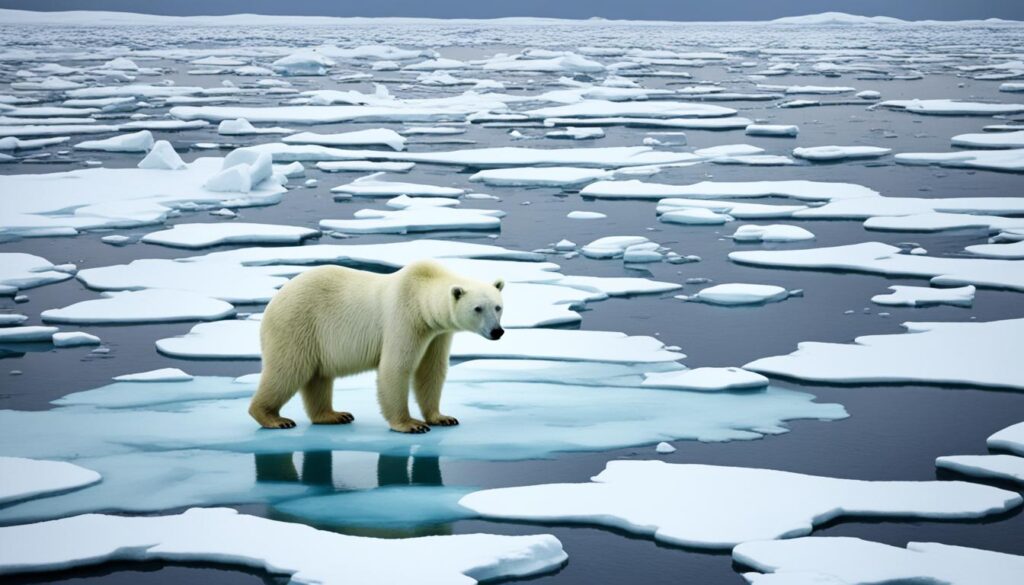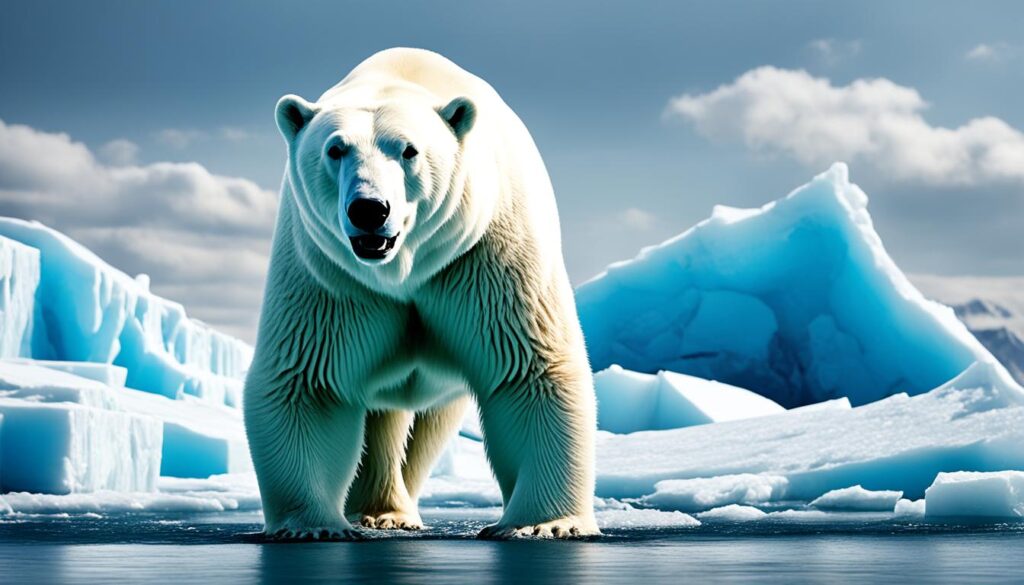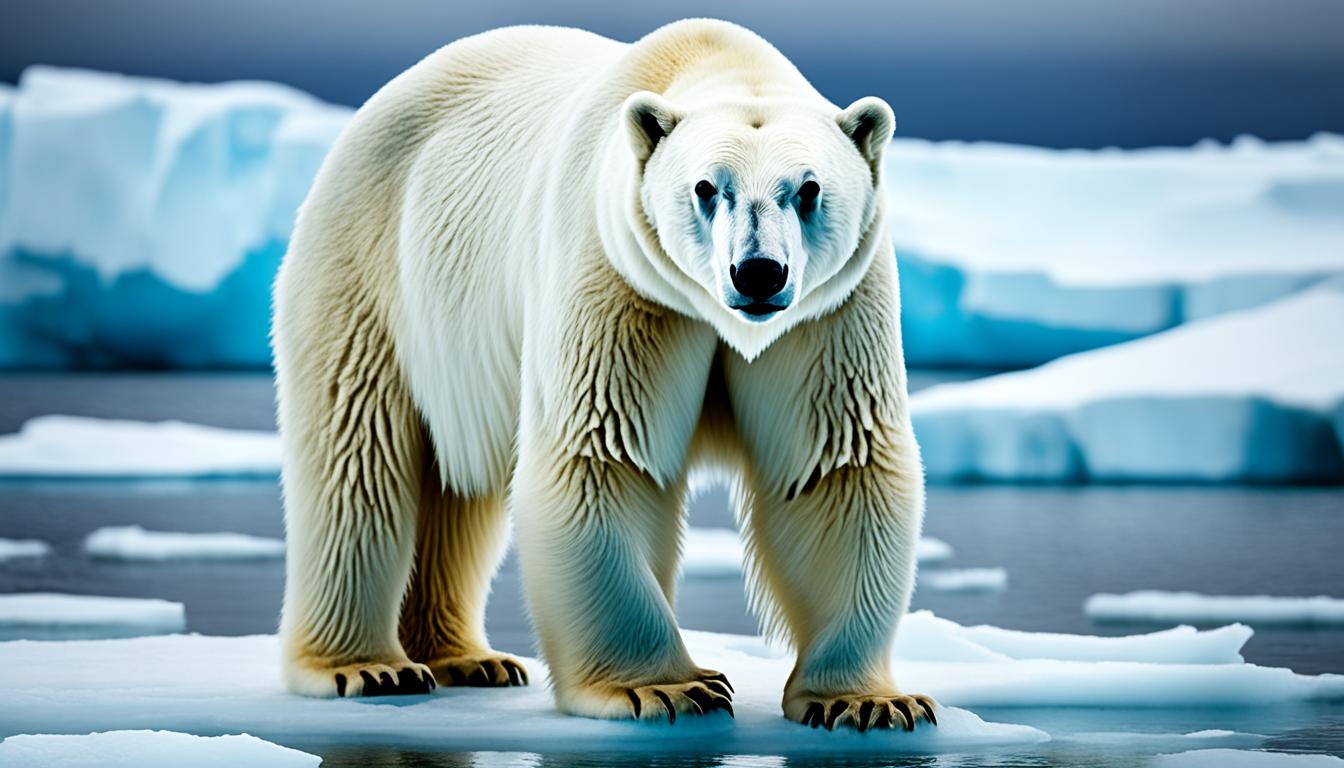Polar bears are the planet’s largest land carnivores and are at risk of dying out. This threat comes from climate change and environmental issues. There are only about 22,000 polar bears left in the wild1. Understanding the many challenges they face is key to saving them. The biggest problem they face is the melting of Arctic sea ice because of global warming. This takes away their chances to find food and lowers their chance of reproducing and surviving2.
Climate change isn’t their only problem. There’s also toxic pollution and oil exploration in the Arctic. These dangers mess with their bodies, poison them, and ruin their homes. These issues add to the threat against them3.
We must act quickly and strongly. To save polar bears, we need to tackle the main causes of threats. This involves cutting greenhouse gas emissions and protecting the Arctic from further harm. Our goal is to keep these stunning creatures in the Arctic’s vast, icy lands for many more years.
Key Takeaways
- Polar bears are facing a serious threat of extinction due to the devastating impacts of climate change and other environmental factors.
- The melting of Arctic sea ice is the primary threat to polar bears, reducing their opportunities to feed and leading to declining reproduction and survival rates.
- Toxic pollution and oil exploration in the Arctic region also pose significant risks to polar bears, disrupting their biological functions and destroying their habitat.
- Urgent action is needed to address the root causes of these threats and preserve the Arctic ecosystem that polar bears rely on.
- Reducing greenhouse gas emissions and protecting the Arctic from further environmental degradation are crucial for the survival of polar bears.
Climate Change: The Greatest Threat to Polar Bears
Today, polar bears face a major danger due to climate change and the loss of their sea ice home4. Since 1979, the Arctic sea ice has been shrinking, affecting the bears4. Temperatures in the Arctic are climbing much faster than the global average4. These changes are very tough on the bears and threaten their existence.
Fewer Opportunities to Feed
With sea ice melting earlier and forming later, polar bears have less hunting time5. They need this time to stock up on energy for the warmer months when food is scarce5. Every additional week without ice in Hudson Bay means they start summer 10 kg (22 lbs) lighter5. They can grow weaker, have fewer babies, and see more of their babies die5.
Fewer Cubs
Climate change directly impacts the ability of polar bears to have offspring5. In some places, mother bears’ milk contains toxins that harm the cubs5. Also, some female bears are partially male due to pollutants, affecting reproduction5. All these issues lower the number of healthy baby bears that can grow up.
The ongoing loss of Arctic sea ice is a significant threat to polar bears4. It’s hard to get exact bear counts in some Arctic areas, making it tough to know the situation everywhere4. Yet, overall, the effects of climate change are clear, negatively impacting these majestic creatures.
“The Arctic sea ice extent has declined since 1979 for every month of the year, and temperatures in the Arctic are rising nearly four times as fast as the global average.”
Polar bears symbolize the Arctic and are deeply impacted by climate change6. Their number in the wild is around 22,000, and they play a crucial role in their environment6. They cover vast areas and are at the top of their food chain6. It’s crucial we protect them and their habitat, ensuring the Arctic remains a balanced ecosystem.
Toxic Pollution: A Silent Killer for Polar Bears
Polar bears, as top predators, face a hidden, dangerous foe in toxic pollution. They roam the vast Arctic and face serious risks from persistent organic pollutants (POPs)7. These pollutants can disrupt how their bodies work and put their cubs in danger7.
Disruption of Biological Functions
Being the kings of the Arctic’s food chain, polar bears gather high levels of pollutants7. These toxins mess with important body processes. They can lower the levels of vitamins, hormones, and antibodies needed for growth, having babies, and fighting off diseases7.
The damage from these disruptions reaches far. It can affect the health and well-being of the whole polar bear population.
Danger to Cubs
Toxic pollution’s danger doesn’t stop with the adult bears. It affects the baby bears too. The pollutants can move from mom to cub through the milk7. This poisons the young ones, reducing how many survive. This puts the future of polar bears at risk, affecting the whole Arctic ecosystem.
Stopping toxic pollution in the Arctic is key for saving polar bears7. We must cut down on harmful pesticides and make tougher rules for pollutants. This is crucial to safeguard these great animals and the Arctic’s fragile balance7.
“Polar bears are facing an unprecedented threat from toxic pollution, a silent killer that jeopardizes their very existence. As guardians of the Arctic, we must act swiftly to safeguard these iconic species and the fragile environment they call home.”
Guarding polar bears against toxic pollution is a big, urgent job7. It requires everyone to help reduce harmful chemicals and choose sustainable actions. Together, we can give a better tomorrow for these amazing bears and their Arctic world7.
Oil Exploration: A Looming Danger in the Arctic
The Arctic, where polar bears live, is in danger from more oil and gas activities8. The Arctic National Wildlife Refuge is vast, covering 8.9 million acres and is very biodiverse9. Yet, the risk that oil exploration poses to polar bears is great. Their survival is at risk from this danger.
Offshore oil operations can harm the sea ice and the polar bears that rely on it9. Spills and leaks can make bears’ fur less insulating, meaning they must use more energy to keep warm. This is vital for their survival.
Polar bears might eat oil while trying to clean themselves or by eating oiled prey9. This can hurt their livers and kidneys. Also, the noise from oil exploration can stress polar bears, making them act out of character.
Imagine if there was a big oil spill in the Arctic. It could be catastrophic for places where polar bears make their dens9. Additionally, oil activities can scare away caribou that polar bears eat, especially the mothers with newborns.
The Arctic is warming fast because of climate change10. This makes protecting the polar bears’ home even more urgent. Letting the oil industry drill in the Arctic could lead to the loss of these iconic animals.
Many groups are fighting to stop the Arctic’s destruction from oil and gas8. They are fighting for stricter rules. The future of the polar bears and the Arctic itself depends on our efforts to save their home.
Polar Bears: Powerful Predators on Thin Ice
Polar bears are among the top hunters in the Arctic. They have special features that help them live in cold places. Their white fur and fat keep them warm in very low temperatures11.
They sniff out seals under thick ice. As excellent swimmers, they cover long distances between ice chunks to hunt their prey11.
These same features that aid their Arctic life also make them in danger. The fast disappearance of sea ice due to climate change is a major issue. It’s making their future really uncertain11.
Climate change is melting the Arctic sea ice fast. It’s shrinking by 14 percent every ten years. This means 770,000 square miles less ice than before. Places like the Beaufort Sea have already seen a 40 percent drop in polar bear numbers over just one decade11.
Less ice means polar bears have to swim more. This can cause weight loss and lower chances of survival11. A big study forecasts we might have fewer than 10,000 polar bears left by 2050 if we don’t change things fast11.
The story of the polar bear shows how serious climate change is in the Arctic. These fierce hunters are now fighting to avoid disappearing entirely. Their struggle shows the urgent need to keep our planet from getting warmer11.
“Polar bears are not built for walking, and as sea ice melts, they are forced to swim more, which can result in significant weight loss and decreased survival rates.” –11
The Arctic Realm: Home to Polar Bears
The Arctic is the home of the majestic polar bear. These bears can be found in the icy landscapes of the Arctic Ocean, Canada, Alaska, Russia, Greenland, and Norway12. As top predators, they keep the Arctic’s ecosystem in balance12. Protecting their home is key to keeping the Arctic healthy and to ensure it supports millions worldwide with resources like fish.
The Arctic is a complex web of life, and the polar bear is at its heart12. They are a sign of how well the Arctic environment is doing. If they thrive, the Arctic does too12. Saving polar bears means we protect the entire Arctic for everyone who lives there.
The Arctic’s grand landscapes have always wowed people12. It’s more than a scenic spot. The Arctic’s role in our planet’s climate is huge, controlling temperatures globally12. So, looking after it includes saving the polar bear and its home for us all.
Climate change is a big problem for the Arctic and polar bears1314. We must act fast to slow down its effects and protect this unique place1314. By saving the bear’s home and fighting climate change, we help keep the Arctic and its people safe.
“Polar bears are a symbol of the Arctic, and their future is inextricably linked to the health of the entire region. Protecting this iconic species means protecting the Arctic as a whole, which is vital for the planet’s climate and the livelihoods of millions of people.”
Polar Bear Extinction Risk: A Threat to the Arctic Ecosystem
The loss of polar bears is a big danger for the Arctic’s balance6. These bears are key in the Arctic’s system, keeping it in check6. Currently, only about 22,000 polar bears are left6. Their low numbers mean we must act fast to save them.
Polar bears are more than just faces of the Arctic; they’re its linchpins6. They control seal populations, which affects the whole food chain5. Without them, the Arctic could spiral out of control, harming its many species6. The Arctic’s health relies on protecting these bears, covering a vast area of over 600,000 sq km6.
Human-caused climate change is the biggest peril to polar bears4. Sea ice has been shrinking since 19794. Arctic temperatures are rising much quicker than the world’s average4. This means polar bears are finding less food, making them weaker when they come to land5. Weak bears struggle to have babies, and their babies often don’t survive5.
Keeping polar bears safe means saving not just a symbol, but the Arctic’s heart6. Human actions, climate change, and conflicts with these bears are harmful6. We must protect polar bears. It’s a key step to keep their Arctic home balanced and healthy.

“Polar bears are not just iconic symbols of the Arctic; they are integral to the region’s food web. Their conservation is crucial for the overall health and resilience of this unique and fragile environment.”
| Threat to Polar Bears | Impact on the Arctic Ecosystem |
|---|---|
| Climate change and sea ice loss | Disruption of the food chain, loss of biodiversity |
| Toxic pollution | Disruption of biological functions, danger to cubs |
| Oil exploration and extraction | Habitat destruction, reduced insulation, poisoning |
Extinction of polar bears is a critical issue for the Arctic6. They’re vital for the region’s balance6. Losing them would harm the Arctic’s life network deeply6. We need to focus on saving polar bears. This includes fighting climate change and other threats546.
Polar Bear Population Decline: A Grim Forecast
The future looks grim for polar bears. Experts predict that almost all groups could vanish by the 2100s if we keep polluting the air15. Even if we cut down our pollution, some bears in the south will still likely disappear. This sad news means we must act fast to save them and their home.
Climate change is making life tough for polar bears15. By 2050, around two-thirds of them might not make it because the ice they need is melting15. In Alaska, all polar bears could be gone. It’s also thought they’ll lose 42% of their living area within the next 30 years15.
Right now, there are between 20,000 and 25,000 polar bears around the Arctic15. The most live in Greenland and Norway. But a big part, about 25%, live near Alaska and move to Canada and Russia too15. Unfortunately, their home is getting smaller each year. In 2005, the amount of ice that stuck around was about 2.05 million square miles. In 2022, it had dropped to only 1.7 million square miles15.
Climate change is a big problem for polar bears because most things affecting their survival are linked to the changing ice15. This includes less ice to live on, more poisons in the air and water, hunting, and too many people visiting their homes16. If we don’t help, some groups of polar bears might be gone forever soon15.
The future is daunting for polar bears. This is why we urgently need to work hard to keep them safe and save the earth’s north for them. As we struggle with climate change, we need to cut our emissions and have a strong plan to help all Arctic life survive15.
“Polar bears have been on Earth for at least 40,000 years, with no significant hope for a quick reversal of greenhouse gas impact.”15
| Metric | Value | Source |
|---|---|---|
| Projected polar bear population decline by 2050 | Two-thirds | 15 |
| Projected polar bear population decline in Alaska by 2050 | 100% | 15 |
| Projected polar bear range loss by 2050 | 42% | 15 |
| Current estimated polar bear population in the Arctic | 20,000 to 25,000 | 15 |
| Arctic sea ice extent decrease from 2005 to 2022 | 300,000 square miles | 16 |
| Decline in western Hudson Bay polar bear population from 1987 to 2004 | 22% | 16 |
| Decrease in polar bear cub survival rate in western Hudson Bay | From 65% to 43% | 16 |
| Decrease in average weight of adult female polar bears in western Hudson Bay from 1980 to 2004 | From 650 pounds to 507 pounds | 16 |
| Increase in ice-free periods in Canada’s Hudson Bay due to global warming | 5 weeks or longer | 17 |
| Projected warming to lead to extinction of Hudson Bay polar bears | 1.6°C to 2.6°C | 17 |
| Decline in Hudson Bay polar bear subpopulation over the last decade | Up to 26% | 17 |
| Decrease in Hudson Bay polar bear population compared to 40 years ago | Around 50% | 17 |
Combating Climate Change: A Fight for Polar Bear Survival
Polar bears are in a tough spot due to climate change. Rising global temperatures and melting Arctic sea ice are serious problems for them18. Only about 22,000 to 31,000 polar bears are left in the wild18. Also, experts fear that two-thirds of them could disappear by 2050 because of climate change18.
To help polar bears, we must cut down on greenhouse gases and use more renewable energy4. The Arctic is warming four times faster than the rest of the world. Since 1979, Arctic sea ice has been shrinking every month4. This makes life hard for polar bears, as their hunting success is low and they need a lot of food to survive18.
We can aid in polar bear protection by tracking their movements and habitats. This includes using satellite images and setting up patrols to keep them safe from dangers such as industrial activities18. The 1973 Polar Bear Agreement helped countries agree on efforts for polar bear conservation across their borders12. These efforts also focus on reducing climate change and lessening human-bear conflicts12.
It’s not just about technology and rules. Fighting for polar bear survival also needs us all to care and act. Taking part in environmental movements and spreading the word makes a big difference18. Fundraising helps, too. It’s used for things like fixing polar bear living spaces and supporting research on polar bears and climate change18.

The issue of polar bear survival is also about culture and tradition. Indigenous peoples have always celebrated these animals. They are a key part of Arctic cultures12. By fighting climate change together and protecting the Arctic, we keep the polar bear legacy for future generations.
Cultural Significance of Polar Bears
Polar bears are very important to the Arctic’s native people. They deeply respect polar bears as smart creatures. For a long time, their culture and way of life have been linked to polar bears. These animals provide food, clothes, and tools. They also inspire cultural expressions and traditions19. Hunting polar bears is crucial for the Inuit. It helps keep their bond with the land strong. It also passes cultural stories to future generations19.
Elsewhere, polar bears are key symbols of the world’s environmental issues20. They’re often in the media, especially in National Geographic, linked with climate change. Known as “charismatic megafauna,” they stand for the danger of global warming. Protecting them is not just about saving a species. It also means valuing cultural links and reminding us to protect the Arctic21. Challenges like food safety for Arctic Indigenous people stress the polar bears’ importance. These threats show why their home must be protected21.
Their influence spreads outside the Arctic too20. A video of a starving polar bear in Canada got 2.5 billion views. This event highlighted climate change’s impact globally. Everyone knows polar bears show the earth’s environmental risks. Saving them is about both the environment and cultural respect
Polar bears get a lot of attention, but they’re not the Arctic’s main focus. The Arctic’s rich ecosystem relies on smaller elements like polar cod. This shows why we must value the bears’ cultural role and their place in nature20.
| Country | Indigenous Population |
|---|---|
| Canada | Over 50,000 Inuit |
| Greenland | Over 50,000 Inuit |
| United States | Indigenous populations including Inupiat, Gwitch’in, Athabascan, Yuppiit/Cupiit, Eyak, Tlingit, Alutiiq/Sugpiat, and Unangan/Aluet |
| Russia | Indigenous groups such as the Chukchi, Yukaghirs, Yakuts, Evens, Evenki, Ddolgans, Nganasans, Enets, Nenets, and Saami |
21 The Arctic is home to over 4 million people. They live in 9 different countries. These include Canada, Greenland, Norway, Russia, and the U.S21. Canada hosts most of the world’s polar bears. It has more than 50,000 Inuit across four regions21. Greenland has a big Inuit population of over 50,00021. The U.S. shelters many Indigenous groups, including Inupiat, Gwitch’in, Athabascan, and more. Russia also has a lot of Indigenous people in the Arctic21.
“Polar bears have become a symbol of the broader environmental challenges facing the planet. Their protection is not just about conserving a species, but about honoring the cultural connections and raising awareness about the need to safeguard the fragile Arctic ecosystem.”
21 Indigenous people use their unique wisdom and knowledge. This includes their cultures, languages, and skills. Their traditional lifestyle is important, giving both cultural and economic benefits. Yet, they face difficulties because of their remote locations and the high cost of food21.
Conclusion
Polar bears face big threats. Climate change and sea ice loss are their biggest problems22. They could be gone by the century’s end without action against climate change22. Some bears have no more room to survive because of the disappearing Arctic sea ice22. Polar bears use the sea ice to hunt, and less ice means fewer bears23. The effects of climate change on them are worse than natural changes over 4,000 years23. If we don’t cut emissions more, they might face extinction between 2050 and 210022.
Other dangers include toxic pollution and oil exploration in the Arctic24. The Hudson Bay has warmed over 1°C in 30 years, which affects polar bears23. If global warming goes past 1.6 to 2.6 °C, bears in Southern and Western Hudson Bay might vanish by 203023. A global temperature increase of 2°C or more could melt all summer Arctic ice in a hundred years23. This would be very bad for polar bears.
It’s important to know the risks polar bears face to help them. Their population is between 22,000 and 31,000 bears. 60-80% live in Canada, in 19 groups. The group that looks after endangered animals says polar bears are “vulnerable.” Three Canadian groups are in big trouble23. Working together with locals and scientists in Canada has kept polar bear numbers steady23. We can help by fighting climate change, lessening pollution, and supporting saving polar bears. This way, we can keep a healthy future for the Arctic.
FAQ
What is the primary threat to polar bears?
How does climate change impact polar bear hunting and reproduction?
What are the effects of toxic pollution on polar bears?
How does oil exploration threaten polar bears?
What are the key adaptations that make polar bears vulnerable to climate change?
How do polar bears play a vital role in the Arctic ecosystem?
What are the potential consequences of polar bear extinction?
What is the current forecast for polar bear populations?
How can we combat the threat of climate change to polar bears?
What is the cultural significance of polar bears?
Source Links
- Polar Bear FAQ | Polar Bears International
- When Will Polar Bear Populations Start to Collapse? | Polar Bears International
- ArcticMeltdown_REPORT.indd
- Polar bears and climate change: What does the science say?
- Polar bear threats – WWF Arctic
- Polar bear: a powerful predator on ice
- Polar Bears Poisoned by Pesticide Pollution
- International Polar Bear Day 2023: 5 Facts About Polar Bears | Earth.Org
- Impacts of oil drilling in the Arctic National Wildlife Refuge
- The new Arctic: Amid record heat, ecosystems morph and wildlife struggle
- Polar Bears Are Starving Because of Global Warming, Melting Sea Ice, Study Shows
- How Climate Change Threatens Polar Bears | Earth.Org
- Study Quantifies Impact of Greenhouse Gas Emissions on Polar Bears | Polar Bears International
- Study connects greenhouse gas emissions to polar bear population declines, enabling greater protections under Endangered Species Act
- Most polar bears could die out by 2050
- Two-thirds of polar bears at risk of extinction by 2050
- Prolonged ice-free periods putting Hudson Bay polar bear population at risk of extinction: Study | WBAL Baltimore News
- Join the Fight: Save the Polar Bears and Their Home
- Cultural Significance | Polar Bears in Canada
- Why the climate movement doesn’t talk about polar bears anymore
- Living with Polar Bears | Polar Bears International
- Climate change: Polar bears could be lost by 2100
- 🐻❄️🐻❄️🐻❄️ Will Polar Bears Go Extinct? | OpenMind
- Polar bears, between hybridization and risk of extinction

